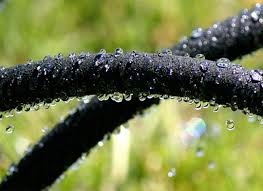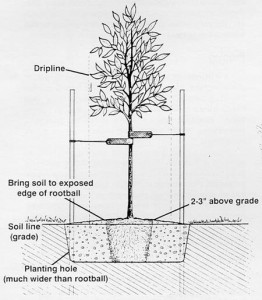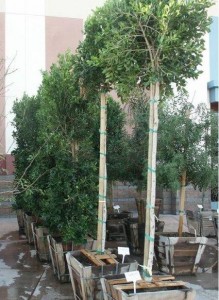Tree Trimming or Pruning?
What’s the Difference and Why it Matters
When people ask for help pruning their trees, many aren’t sure what to ask for. Tree trimming or pruning? They know their trees need work but they don’t how to describe it. Tree service ads don’t help. They use terms such as trimming, cutting, topping, rounding, crowning, heading, shearing, lacing, sculpting, wind-sailing and the list goes on. The words describe pruning operations but don’t explain what will be done. They leave tree owners scratching their heads and often disappointed with the results.
To help clear up the confusion, the American National Standards Institute (ANSI) developed a pruning standard called the the ANSI A300. The A300, based on best management practices for tree health and safety, was created to help arborists write better pruning specifications so tree owners would know what work was being done.
The A300 recommends that proposals clearly state:
Pruning objectives: Such as structural improvement, size reduction, building clearance, etc.
Pruning types to be used: Such as crown cleaning, thinning, raising, reducing and restoring.
Minimum and maximum branch diameter for cuts: ½ inch, 2 inch, 6 inch, etc.
Maximum % of foliage removed: 5%, 10%, 25%, etc.
Tree pruning specifications are to an arborist what a set of blueprints is to a building contractor. They define the pruning outcomes that are planned and how they will be achieved. They tell what will and will not be done. They put the contractor, the tree owner and the crew all on the same page. And in the end, they clarify expectations and create a win-win for everyone.
When contracting for tree pruning services, request that your tree care provider define terms, establish clear objectives and describe the specific pruning types the workers will employ to achieve those objectives. If service providers have difficulty describing the scope of work and measurable outcomes, it may be an indication that they lack the knowledge and skill to prune trees correctly. And the last thing you want is for your trees to be damaged, sometimes beyond repair, by unacceptable pruning practices such as topping or lion’s tailing.
For a better experience, consider selecting a qualified company that provides clear pruning specifications based on the ANSI A300. You’ll be glad you did, and so will your trees!

Prepare Your Trees for Summer Part 4
Rain and Wind Dynamics
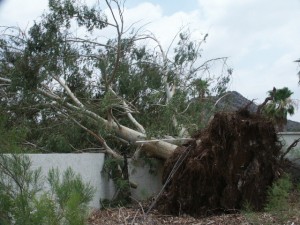
Wind forces act upon trees in unique ways depending on the distribution of foliage throughout the entire tree crown as well as along individual branches. Thinning cuts as well as reduction cuts help reduce the drag (wind resistance) on the tree canopy and lower the height of the pressure center to larger diameter wood. To prepare your trees for summer winds, a combination of both types of pruning is needed but especially reduction pruning. Research has shown that reduction pruning to alleviate end weight is the best type of pruning to decrease risk of tree and branch failure.
A big mistake is to over-thin trees with the idea that this makes them safer. There is an unacceptable pruning technique called Lion’s Tailing that removes an excessive number of smaller branches from a tree’s interior at the neglect of the outer third of the crown. You’ve probably seen these sorry, stripped-out specimens on your street. The wind blows through their lower crown but is concentrated now in the lion tails of heavy foliage that flag in the wind and often break. Properly thinned branches have an even distribution of foliage along the entire length of the branch. Consequently the force of the wind is now evenly distributed along the length of the branch, transferring that force to the base of the branch where the diameter is greater and it can better support the branch movement.
Tips to prepare your trees for summer storms:
- Plant trees in groups. They buffer the wind from their neighbor trees.
- Turn off your water! Excessive irrigation prior to a wind event can lead to entire tree failure. So turn off your watering system when a major monsoon storm is coming.
- Don’t Lion Tail your trees.
- Concentrate pruning in the outer third of the canopy using primarily reduction pruning techniques. Proper reduction pruning requires special skill to avoid making heading or stub cuts. If your trees are large or have excessive end weight, consider hiring a Certified Arborist to help out.
If you prune your own trees, consider attending one of my upcoming pruning classes. I will be teaching a class at the Desert Botanical Garden on June 22nd. Click here for more information or to register.

Prepare Your Trees for Summer Part 3
Irrigation
To prepare your trees for summer, there is nothing more important than proper watering. Doing it well can be a challenge in the desert, but the following tips should help.
- The first secret of watering desert trees is to know your how well your soil holds water. Because different soils drain differently, they require different amounts of water and different watering frequencies. You can use a soil probe, available at most good nurseries, to determine how quickly your soil dries out and needs water again. More on soil probes below.
- Once you know the rate that water percolates through your soil, you can precisely set the DURATION of the irrigation cycle in order to water to the full depth of the root zone.
- This is important because trees are commonly over-watered. We assume trees need more water because the SURFACE soil looks dry. But many desert soils have a high water-holding capacity. Three to six inches below the dry surface, the soil profile is cooler and can often hold water for several days or weeks.
- The point is to avoid putting water on top of water. This is not only wasteful; it also sets up conditions for various disease pathogens.
- Using the soil probe, you can also determine watering FREQUENCY, that is the number of days between waterings. The goal is to apply water when the root zone completely dries out. A simple test to determine watering frequency is to watch your trees for signs of afternoon wilting. If the leaves of your tree or shrub begin to curl at the edges (wilt) after 10 days, set your watering cycle for 8 or 9 days.
Stay tuned for my series on Irrigation next month. In the meantime, for a closer look at watering and using a soil probe, visit our Integrity Tree Service Fact Sheets here.

Prepare Your Trees for Summer Part 2
Staking and Guying
After you have selected a great tree, it may be necessary to stake it temporarily until it gets established. Here are some tips on tree staking and guying to help prepare your trees for that first summer wind storm.
After planting, only stake or guy your tree if necessary. The goal is to train the tree to be on its own, not to prevent it from moving. A staking system should serve only as a failsafe.
If the tree needs to be staked, suspend it between the stakes firmly enough to prevent it from falling over but loose enough to allow it to move slightly in the wind.
Use a soft material such as nylon webbing to tie the tree to the stakes.
If the tree has a stake tied directly to the trunk, it should be removed at the time of planting. This “travel stake” is only intended to get the tree to its final destination and can cause damage to the trunk if not removed.
Finally, be sure to monitor the stakes regularly and remove them as soon as the tree roots are anchored in the surrounding native soil, usually within the first year after planting.
Next up: Prepare Your Tree for Summer Part 3 – Irrigation
Prepare Your Trees for Summer Part 1
Tree Selection and Planting
Trees are one of our most valuable assets. They provide shade, energy savings, wildlife habitat, aesthetic beauty and increased property value to our homes, businesses and communities. Here are some tips on tree selection and planting to help prepare your trees for summer.
- Start by buying good quality plant stock, preferably trees with low growth along the main trunk. These trees are less susceptible to sunburn. They are also more stable due to better trunk taper. They may not even need staking or guying. Avoid lollipop trees like the two trees in the foreground of the photo. The trees behind them would be a better purchase.
- Consider buying native or desert-adapted trees when possible. They normally have a lower profile in the landscape and are less susceptible to wind damage. They also are better adapted to our local soil conditions, native pests and pathogens and other stresses common to the low desert.
- Plant trees in groups when possible. They buffer the sun and wind from their neighbor trees.
- Minimize pruning after planting. New trees need as much foliage as possible to create the energy reserves for healthy future growth.Avoid removing watersprouts. These are the small shoots growing along the lower trunk and main branches. Watersprouts help their parent branches develop taper needed to support increasing end weight as trees mature. They also shade interior branches and prevent sunburn.
Next up: Prepare Your Tree for Summer Part 2 – Staking and Guying

Tree Frost Damage Recovery Plan
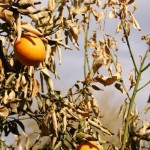 Pruning out dead leaves and branches at the right time and in the right way is critical to plan t health. Here are some guidelines for getting your frost-damaged plants back on track.
Pruning out dead leaves and branches at the right time and in the right way is critical to plan t health. Here are some guidelines for getting your frost-damaged plants back on track.




